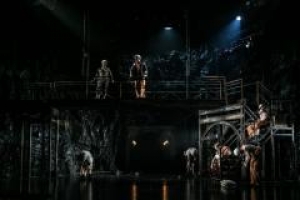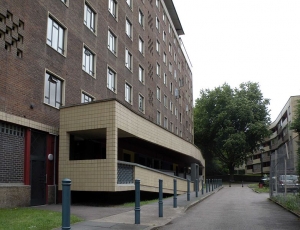
Wonderland
Ross Bradshaw reviews a recent play at the Nottingham Playhouse about the 1984 Miners' Strike.
Wonderland, written by Beth Steel, was the first play of the new artistic director at Nottingham Playhouse, Adam Penford. It ended with a full house and an almost completely standing ovation. It was, I gather, not the first ovation during the run.
Wonderland was set during the lead up to and throughout the year of the miners' strike of 84/85. Much of the play was set underground with a terrific set by Morgan Large which gave you both the sense of grandeur in some of the big halls underground, and the claustrophobia of the lifts taking miners to the coal face.
Like many in the audience, I was around during the strike in Notts., and knew how it ended, but the play's and the strike's turning points still kept me tense. In fact knowing what would happen created more tension, such as when the police waved pickets through to Orgreave. We all know now it was an ambush. There were people in the audience last night who had been at Orgreave on the day.
The whole play was well acted. The Tory wet, Peter Walker, conflicted over doing a job he only half believed in was, perhaps, the stand out. But the group of miners, from hardened men with their pension in sight to new, nervous recruits, played so well. I had not picked up in advance they had to sing and dance, at the same time as looking like they were people who worked hard, smeared in filth. Naomi Said, the Movement Director, deserves credit for the choreography on stage.
The creepy David Hart was, perhaps, played too much for laughs and being identified as a Jew (which he was not, other than by his father's family history and his experience of anti-Semitism at Eton)
made me uncomfortable. But yes, he was creepy like that in real life and, like the incoming "butcher" NCB director Ian MacGregor - and the working Notts miners, for that matter - he was considered expendable in the end by Margaret Thatcher.
Being Notts., of course, most NUM members did not strike, and some who did were starved back before the end. The arguments on the picket line were intense, and you felt for the young lad who'd had to kill his dog because he could no longer afford to feed it. Eleven months in, people had sold everything they could sell.
The play was not all grim. Pit humour was good. The best laugh was when a car load of pickets were stopped and, knowing they would not get through anyway, and said to the police they were Morris dancers. At the end, the cast individually mentioned some of the stories - of those who had died during the strike, including the three children who'd lost their lives scavenging for coal. The three miners who had committed suicide. The taxi driver who was killed taking a scab to work. The striker David Jones, killed at Ollerton on the picket line. The devastation of the communities left behind.
The audience rose and saluted the cast, and they dropped down Welbeck NUM banner, where the writer's dad had been a miner. As I stood I was thinking of loyal NUM members I know like Eric Eaton, Keith Stanley and Brian Walker, who died a few weeks back, and others I'd met in what is now the Notts Retired and Ex-Miners group. And four women, active in the strike, all now dead - Liz Hollis (who killed herself during that year), Pat Paris, Ida Hackett and Joan Witham.
In discussion with friends, it is the absence of women that comes up. There is power play between Hart, Walker, MacGregor and the ideologue, Nicholas Ridley. Underground, and later on the picket line, there is the traditional miners' camaraderie, a brutal reminder from the experienced "Bobbo", played by Tony Bell, that every miner watches each other's back (the symbolism of that statement is not lost) and a moving, even loving scene when the miners washed each others back, in the shower after a shift. This was a play about men, and men's relationships. Yet women, in Notts and elsewhere, were visible in the strike, in the soup kitchens, on platforms and on the picket lines. At Welbeck as much as anywhere. A few lines in the play reflected this, but it would have been quite easy to include women on the picket lines without needing to change the nature of the production.
Still, a fantastic effort by the whole ensemble.
Wonderland has now finished at the Nottingham Playhouse, but may be touring elsewhere. For a short film which puts the role of women in the miners' strike centre stage, see here.


